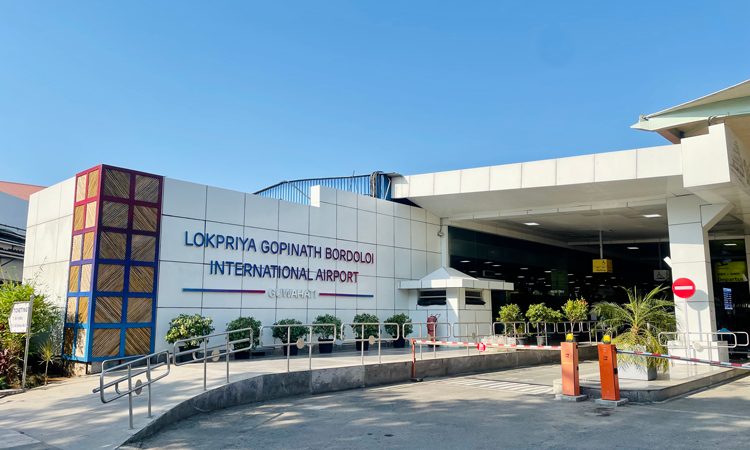Automated Baggage Handling System to transform passenger experience at Guwahati International Airport
- Like
- Digg
- Del
- Tumblr
- VKontakte
- Buffer
- Love This
- Odnoklassniki
- Meneame
- Blogger
- Amazon
- Yahoo Mail
- Gmail
- AOL
- Newsvine
- HackerNews
- Evernote
- MySpace
- Mail.ru
- Viadeo
- Line
- Comments
- Yummly
- SMS
- Viber
- Telegram
- Subscribe
- Skype
- Facebook Messenger
- Kakao
- LiveJournal
- Yammer
- Edgar
- Fintel
- Mix
- Instapaper
- Copy Link
Posted: 10 March 2023 | Gaurang Harit | No comments yet
For Issue 6 2022, Gaurang Harit, Deputy General Manager and Head – Airport Systems – Projects at Adani tells International Airport Review about the new integrated terminal building being built at Guwahati International Airport and the state-of-the-art baggage handling systems that will be central to handling the increase in passenger loads in the future.


The North-East region of India spans across different states collectively known as the Seven Sisters and is one of the most beautiful and diverse regions in the country that is yet to tap into the growth potential owing to limited connectivity to the region. With the Act East policy of the Indian government, this region is surely attracting good investments in key sectors like infrastructure and air connectivity. The region has witnessed the fastest air traffic growth in the last five years compared to the other regions across India.
Guwahati International Airport (GAU) serves as a gateway to the North-East region, and the present terminal building with capacity of 2.8 million passengers per annum (PPA) is already reeling under high loads, thanks to the increased air traffic and additional flights to the region post-COVID. Since the existing terminal building was commissioned decades ago, the facilities and infrastructure is now quite obsolete as per the current requirements.
The present baggage handling system consists of standalone security screening of bags followed by 34 check-in positions, out of which only seven are connected with two-stage check‑in conveyors feeding to the takeaway belt, while the rest are equipped with shared weighing scales between each pair of check-in counters, with complete manual handling from the counter to the takeaway conveyors. weighing scales between each pair of check-in counters, with complete manual handling from the counter to the takeaway conveyors.
Due to this, check-in operations are both time consuming and labour-intensive. Also, the baggage make-up area is spatially constrained as there are only two make-up laterals with gravity rollers to transfer the loads from check-in to the processing area. Currently there are insufficient dolly parking positions and manual sorting of bags coming in from the laterals are quite an exhausting process for the airlines ground handling teams.
The terminal will boast state-of-the-art infrastructure with an inline baggage handling system that can cater to baggage throughput of 2,400 bags per hour”
Considering the increase in passenger loads over the next decade with the existing infrastructure already reaching its threshold capacity, a brand-new integrated terminal loads over the next decade with the existing infrastructure already reaching its threshold capacity, a brand-new integrated terminal building is under construction that is envisaged to go live by the year 2024. Phase 1 shall cater to passenger loads of 13 million PPA.
This is perhaps the biggest airport upgrade in the region with a massive improvement compared to the existing facilities. The terminal will boast state-of-the-art infrastructure with an inline baggage handling system that can cater to baggage throughput of 2,400 bags per hour. For the departing passengers, there is a total of four check-in islands with 16 desks per island, so a total of 64 check-in positions with a mix of two‑stage check-in conveyors and self-baggage‑drop that shall provide flexi check‑in facility for the airlines to optimise the check‑in allocation.
As part of five level inline hold baggage screening system, all bags from check-in shall be routed via takeaway conveyors to the baggage plant at a mezzanine level for 100 per cent baggage screening via inline CT X-ray machines at Level-1.
All bag images shall be sent to the remote screeners that shall screen the bags to ensure safe bags are routed to their respective destinations, while the suspicious ones are routed to the next set of screeners with increased evaluation times. Rejected bags from this level are then routed to Level-3, where there are four rooms that are equipped with standalone screening machines, explosive detection systems and manual bag search facility.
Considering the increase in passenger loads over the next decade with the existing infrastructure already reaching its threshold capacity, a brand-new integrated terminal building is under construction that is envisaged to go live by the year 2024″
Cleared bags from all levels are connected to the sortation lines that routes the bags to either of the four designated make-up carousels. Manual encoding stations are built in the system for reconciliation of problem bags, thereby ensuring seamless routing of bags to their destinations. The system has been designed to minimise the passenger processing times at the check-in, while also empowering the ground handling teams with an auto sortation system that helps to reduce the manual efforts while maintaining highest standards of serviceability.
The inbound baggage system comprises of six reclaim carousels, that are spread across the Arrival Hall with provisioning for customs screening of international flights.
The entire system shall be centrally monitored via a dedicated baggage control room with smart videowall to aid the operators in efficient and seamless operations. The system design is thoughtfully done with sufficient redundancies across all levels to ensure minimal impact to operations during major breakdown or maintenance activities.
Biography


Gaurang Harit
Internationally awarded, impact focused Specialised Airport systems Expert & certified Project Management Professional with around 15 years of experience in designing, innovating, and automating some of the largest and advanced material/baggage handling systems globally. Successful track record of managing both greenfield and brownfield projects with extensive experience in end-to-end delivery including design, bid evaluation, project & construction management, erection, commissioning, system integration, ORAT and O&M coupled with enriched experience in strategic multi-stakeholder management gained while working across different stakeholder positions including airport operator, contractor, consultant and OEM. Currently leading specialised airport systems with Adani Airport Holdings Ltd. as a part of central team responsible for design, planning and execution of airport expansion projects for specialised airport systems including baggage handling system, passenger boarding bridges, horizontal and vertical transport system, visual docking guidance system, building management system, fixed ground services (GPU & PCA).
Issue
Related topics
Air traffic control/management (ATC/ATM), Airside operations, Baggage handling, Capacity, COVID-19, Passenger experience and seamless travel, Terminal operations


















